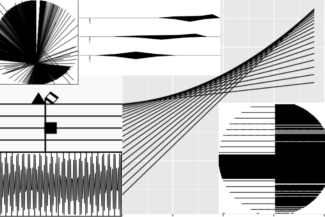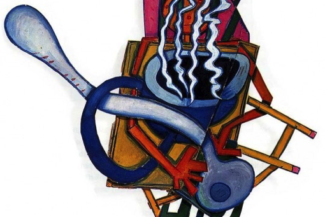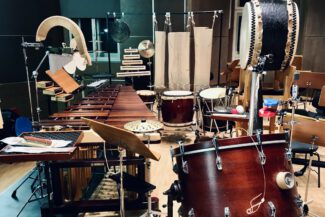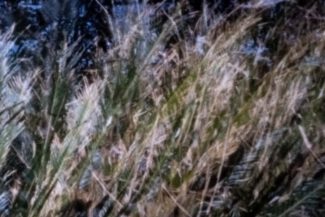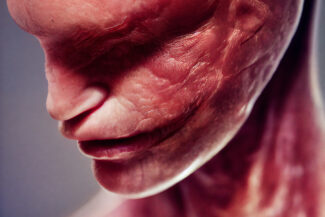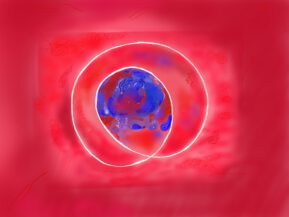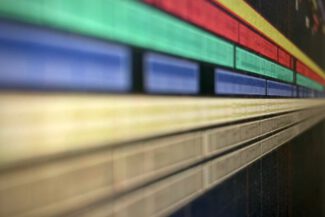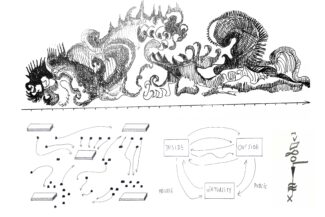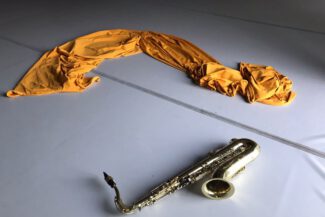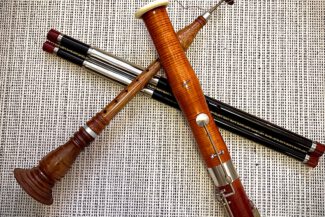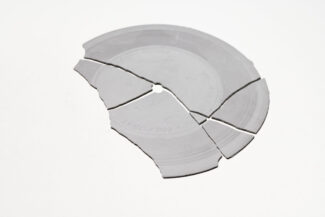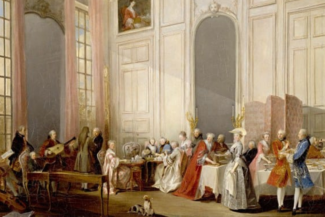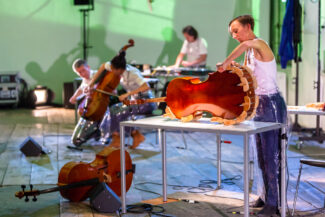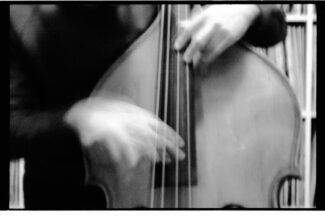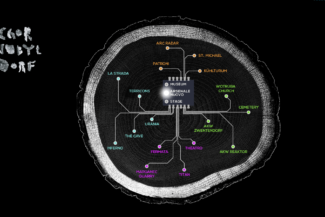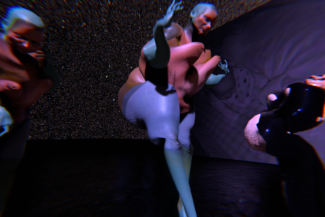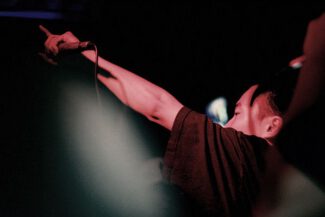Dustin Zorn – Connect create reflect
This concept takes into account that the performance ecosystem is indeed something composed, specially designed and crafted (in some cases, it can even define the identity of a specific work) [2]. The term virtuosity implies the potential to learn and master the underlying skills over time [3].
Two questions are at the center of this artistic research project: What skills are part of second-order virtuosity in relation to a particular artwork or artistic practice?What are individual strategies for achieving second-order virtuosity?
To answer these questions, the project makes connections in two directions.
- Historical live electronic setups and the skills required to develop and perform with these setups become part of the research process. A thorough analysis of a piece developed in the context of a live electronic setup is followed by an artistic experiment in which either the setup or the musical content of the historical piece is intentionally changed. The performance ecosystem that emerges from this process is tested in a concert context. This opens up the possibility to compare the artistic result with the historical model and allows to reflect on the impact of the design decisions made.
- international exchange is developed through joint projects with contemporary live electronic composers and performers. During these projects, participants are invited to design live electronic setups based on their individual expertise and to share their skills with each other. This allows for the comparison of individual strategies for designing setups by artists from different regions and aesthetic backgrounds, and possibly the acquisition of new skills not previously used by the participants. The internal goal of these projects is a performance with the setups and musical material developed within a certain time frame.
For both directions of research, the goal is to create time-based artworks that allow reflection on the impact of the individual skillset required for the design of the setups shaping the artworks. Finally, a new question arises: how can the reflection of second order virtuosity form an individual second order practice? Second order practice means a set of methods that are derived from the strategies found in the project for the active and purposeful exploration and acquisition of skills useful for designing live electronic setups. This second-order practice is developed as a working method for the external participants of the project as well as in my own artistic practice and discussed in a wider public through concerts, workshops and presentations.
[1] Dominik Hildebrand Marques Lopes, Dominik, Hannes Hoelzl, und Alberto de Campo, „Three Flavors of Post- Instrumentalities: The Musical Practices of, and a Many-Festo by Trio Brachiale“, in Musical Instruments in the 21st Century: Identities, Configurations, Practices, hg. von Till Bovermann u. a., 1st ed. 2017 (Singapore: Springer Singapore: Imprint: Springer, 2017), https://doi.org/10.1007/978-981-10-2951-6.
[2] Friedemann Sallis u. a., Hrsg., „Dwelling in the Field of Sonic Relationships ‘Instrument’ and ‘Listening’ in an Ecosystemic View of Live Electronics Performance“, in Live Electronic Music: Composition, Performance, Study, Routledge Research in Music (Abingdon, Oxon ; New York, NY: Routledge, 2018).
[
3] K Anders Ericsson, Ralf Th Krampe, und Clemens Tesch-Romer, „The Role of Deliberate Practice in the Acquisition of Expert Performance“, o. J.
Athanasia Kontou – Getting Personal
With this research project, I want to place the theme of personal, emotional vulnerability in the heart my practice.
Expression of emotion and emotionality have been themes in and out of discourse within Wester Art music. In other artforms, such as popular music, stand-up comedy, and performance art, expression of personal vulnerability is consistently and opaquely used as material.
I want to explore methods through which I can translate personal emotions to contemporary classical concert hall music. At the same time, I want to explore ways of expanding my practice to an experimental one, with elements from the aforementioned artforms. The question raised is how these extra-musical elements can aid in the communication of this vulnerability. Also, how can the vulnerability be reclaimed as creative power, and how can it foster an emotional connection with the listener/receiver.
As the autoethnographic research unfolds, personal vulnerability will acquire different connotations and expressions, with inspirations and resonances from/in existential philosophy, gender studies, ecofeminism and more.
David Panzl – Marimba Spriritual
In one of the many Japanese music lessons concentrating on Noh instruments, my teacher Akikuni Takahashi confronted me with an old recording from the Chichibu region in Saitama prefecture.
It was live footage from the famous Yatai-Bayashi, featuring Japanese Taiko drums and flute. This festival music immediately felt very familiar to me as I could recognise the rhythm and melody of the world famous „Marimba Spiritual“ by Minoru Miki. It was no secret that Minoru Miki researched in traditional music and even published a composition guide for Japanese instruments. He also mentioned in the liner notes of the Marimba spiritual that the rhythms used in the second part of the piece are based on the famous Yatai-Bayashi, but what really shocked me, was the totally unique quantisation of the beat. Unlike the westernised performance practice of playing the eights notes straight on the grid, the drummers from Chichibu added a certain swing to it by delaying and rushing certain notes. (Please see the graphic for better understanding later in the text.) It blew my mind, that one of the most frequent performed pieces of our standard repertoire totally lost its connection to the original groove. The disconnect was so obvious that suddenly even my most loved recordings of this piece felt wrong. The music lost a big amount of its driving force, which might have lead the young generation of percussionists to the practice of playing the piece faster than indicated in order to compensate for the lack of energy.
This discovery initially sparked the idea of rediscovering this well known composition. I wanted to „resound“ Miki´s most famous work as there was not one record out, which respected the ethnic origin of this music.
It took many years to collect all the required instruments, to become proficient in playing traditional techniques and to research in this topic. I travelled to Chichibu to experience the original sound and learn how to play the traditional patterns. I also performed concerts together with Ichitaro, a former taiko player from the world famous group Ondekoza, (the first modern taiko group) and finally found Boris-Alexander Bolles as a great partner who would help me with sound engineering and technical matters.
Necessary steps:
- Analysing the rhythmic patterns of different performers in this region to extract the overall essence of the „swing“. My published method book, „Rhythmic Morph“ was of great help in this process, as it covers the method how to write and perform morphed rhythmic patterns. It was important to not only analyse the rhythmic placement of the notes but also the velocity of each note by using AVID Protools software. To get a representative model we had to compare many different players and calculate the common average using program written in MATLAB.
- Producing a play along as practicing tool and reference track for the overdub-production. It was necessary to write the full score with the notation software Finale, export the MIDI data and transfer it to Ableton Live where it was possible to apply groove parameters to the taiko sound samples.
- Programming the required accelerando from the first to the last note of the second part under consideration of the changing amount of „swing“.
- Practicing all different parts of the piece by using the play along.
- Finding the perfect venue for the recording. The natural reverb and appearance should mimic a traditional Taiko-Dojo, which are usually wooden structures with a characteristic sound and video-graphic aesthetic.
- Recording the music in a multitrack method. Filming the performance.
- Cutting, layering and mastering the recording and Producing an artistic music Video.
- Interviewing Prof. Keiko Abe about her thoughts of the new approach, its impact on the scene and how she thinks the composer Minoru Miki would have felt about it.
Project Goals and artistic research issues:
- Work out and reflect on the influence of Japanese traditional music on the classical percussion solo repertoire of the 20th century. Is the influence comparably big as it was in the visual arts through Ukiyo-E prints?
- Reinvent the performance practice of classical percussionists when working on interpretation of music with ethnic backgrounds, by giving them valid informations especially designed for them without language barrier.
- How is it possible that one of the most performed pieces in concert percussion history never was viewed from a music-ethnological perspective? Even my colleagues of the concert percussion field in Japan never knew of the special Yatai-Bayashi phrasing. Is there a barrier between classical and traditional musicians? Could it be, that Minoru Miki based his composition on a much more modern, straight version of this rhythm which was played worldwide by Ondekoza? This would mean that it could even be wrong to add the traditional interpretation?
- A very interesting question of my research would also be if it is cultural appropriation to learn traditional performance practices in depth to play in a more culturally informed way. Or how much cultural appropriation is necessary and legit in order to fulfil the role of the performer on stage, especially if the composition itself is based on ethnic music.
- Furthermore I question how other pieces with Japanese roots suffer from the same phenomenon. Therefore I want to research on a selection of works which are part of international competitions, or belong to standard concert programs.
Ginan Seidl – Tonales
The artistic research project Tonales is based on the phenomenon of the “tonal” (or “tono”) in the indigenous culture of Mexico: a spiritual double of a human being. The word originally stems from the Nahuatl (native Mexican language) word “tona” or “tonatl” which means both spirit and sunlight.
As guardian spirits, tonales appear in various places in Mesoamerica and – depending on the community – can take on different shapes and forms, usually appearing in the form of an animal.
The project is based in the community of the Macehual in Puebla, Mexico. In the context of oral traditions, ritual acts, and other aesthetic practices, it explores the (in)visible existence and influence of tonales as non-human beings, and observes the interactions between local communities and their environment. To account for the liminal, relational mode of existence of tonales, who traverse ontological registers not least between humans and their material and animate environment, the world is understood as a relational assemblage of acting actors according to indigenous cosmologies, and as such is incorporated into the cinematographic practice of the research. The space in which the artistic research is embedded presents itself in an inescapable intertwining of human and non-human actors. My artistic practice is situated at the intersection of audiovisual documentary and essay film, installation art, and ethnography, and is generally characterized by a great sensitivity to the subjects and „objects“ of my projects. In the realization of Tonales, I rely on the experience of working in the milieu and on a production process influenced by the social context. Collaborative production processes within communities result in experimental film fragments that are presented in the form of a spatial installation to allow for a non-linear and multi-perspective arrangement. The film installation and related experience aim to reveal the imaginative space of the tactical film experience of the multi-layered cosmology and modalities of tonales. The audiovisual material is interwoven with essayistic and poetic texts that reflect interactions with communities, my perspective as a researcher and filmmaker and documentary approaches to visibility and accountability when working with ephemeral phenomena and non-human species.
Supervisors: Gudrun Rath, Christine Maier, Evelyn Annuß, Stefanie Lorey
Ragnheiður Erla Björnsdóttir – Outside
This artistic research project explores the voice through embodiment and sustainability with the aim of creating vocal sculptures as a practice of connectivity. By learning through the body, it seeks to engage in complexities and question how embodied singing can lead to a deeper understanding of the intersecting crises of environmental justice and social inequity. For the development of vocal sculptures, the project will establish co-creative embodied vocal composition methods that centre voice as material for performative sculptures.
Supervisors: Johannes Kretz, Weiya Lin (Hande Saglam), Evelyn Annuß
Matija Schellander – Polymorphic Sound Objects
Logothetis has used modern technologies of his time and was interested in innovative developments and progresses. Therefore he used tape machines in the style of Musique Concrete and modular synthesizer from 1960 onward and has later composed using an early computer system at EMS Stockholm in 1980. Logothetis was unsatisfied with the sound quality and lack of overtones in the amplification systems he had access to in the 60ies and 70ies, finding improvement in the digital technology he used at EMS.
In this context, there are several questions arise.
What influence do the technical possibilities have on compositional processes and the artistic outcome? How would a tape composition had been realized with nowadays digital technology, what would be gained in this transformation and what would be lost? How would his electronic music sound if he had the instrumentarium of Jeff Mills – one of the pioneers of Detroit Techno – a Roland TR-909 drum machine?
In Logothetis` texts about his music, he often uses terms such as multi-dimensional and polymorph. His scores being very specific about the character of a composition on the one hand and at the same time leaving space for interpretation and liberty for the performer. Logothetis approach is influenced by game theory and cybernetics and therefor opens questions about political dimensions, authorship, democratic processes, decision-making and responsibility.
Composition, live-electronics, musical performance, sound sculpting, notation, graphic scoring, drawing and sound engineering are the artistic and academic sub-disciplines relevant for this project.
Matija Schellander, born 1981 in Ludmannsdorf-Bilčovs (Austria), studied double bass at the Conservatory of the City of Vienna and Electroacoustic and Experimental Music at the University of Music and Performing Arts Vienna.
He lives and works as a composer, double bassist and electronic musician in Vienna, composing for music ensembles, theater, contemporary dance and film. He has performed across Europe, North America and Asia and has collaborated with many highly regarded musicians.
Rdeča Raketa is his electronic music duo with composer and performer Maja Osojnik. Together with author Natascha Gangl they also run the Soundcomic group, which specializes in a reimagination of the radio play. In recent years a focus of his work is composition for theater, with productions in Austria, Germany and Switzerland.
Supervisors: Jorge Sanchez-Chiong, Annegret Huber, Thomas Grill
Arne Vogelgesang – Virtual Flesh
About the artist: As a founding member of theatre label internil, and under his own name, Arne Vogelgesang has been devising theatre & performance projects since 2005. He has been especially interested in new forms of radical political subjectivation online and the narratives and memetic fields they embed themselves into. Arne also makes video for others, gives talks & workshops on his research topics and occasionally writes texts about them.
More: https://vogelgesang.internil.net
Supervisors: Susanne Granzer, Evelyn Annuß, Johannes Kretz
Ettore Biagi – Unison
The mechanics, and therefore the meanings of listening undergo significant changes every time the accessibility of musical content reshapes. In the course of western music history (ever since the invention of ecordings) the proximity of consumers and music product has been regulated by technological progress; it is therefore likely that the present, unprecedented level of accessibility witnessed in digital fruition, is just another step towards an even more accelerated frame of music consumption. The mean, nevertheless, shapes the user. While the strongest domain of classical music industry relies on long forms in multiple movements, high linguistic density and, most importantly, historicised interpretation codes, digital fruition (as it is designed by its leading competitors) is instead characterised by very short listening tempi and equidistance of incredibly diverse, historically defined aesthetics from the consumer, and complete control over the product. Observing the rules of “high-voltage consumption” of musical content on digital platforms it’s impossible to ignore how those rules are re-defining the paradigm of listening, setting up future audiences for an intrinsic inadequacy to live concerts.
The huge divergence between what we, as musicians, are trained to accomplish in relation to an audience during a traditional concert experience, and the parameters of music consumption is as significant as , I think, understudied by the ones who should acknowledge it the most: the performers themselves. This leads, therefore, to the following Research Question:
How can I, as a contemporary music interpreter, define, seek and create a Resonant listening experience today?
While the concept of Resonance comes from the philosophy of Hartmut Rosa, it constitutes a research horizon itself. There is no absolute definition of Resonant Listening. Whereas, instead, there are just defining elements, some of which appear clear, and some other need to be tested through research. In the initial stage of the dissertation Resonant Listening is defined as non-passive and non-mute: it does not shut the listener in a state of marginality/irrelevance and it’s able to produce genuine, deep and immediate emotions, eradicating numbness and indifference from the spectrum of the possible reaction to the music.
Throughout the course of the research I, therefore, aim to conceive and create a series of performances, each one of which will address partial but relevant issues concerning Resonant Listening. Every aspect of the performances must change from one case study to the other: the social context, the repertoire, the venue, the musicians and most of all, the aspect of fruition that I want question. In each performance the audience will be able to leave a trace on the event: an archivable media of any sort that will stand both as crystallisation of the listening act and a data which reading and observation will guide me into the shaping of the next questions and the next performances. The aspiration of this path is to restore not only a Resonance, but a real unity (a Unison) between music making and listening. Both for the present and, hopefully, for the future.
Supervisors: Heinz-Peter Linshalm, Axel Petri-Preis, Susanne Granzer
Tong Zhang – Out-of-sync
Out-of-sync normally refers to a technical issue in the process of filmmaking, either during the production or in post-production, out-of-sync is mostly understood as a technical phenomenon of a time shift between image and sound. But more than just a technical issue, in the post-synchronization era of cinema, sound and image are made separately and work in their way of storytelling. Michel Chion introduced the concept of “a contract between sound and image” and the “Horizontal and Vertical perspectives on audiovisual relations”. The research project is trying to understand the different horizontal and vertical perspectives between image and sound both technical and artistical, through experimental practice.
In old Greek, the word “Techne (Greek: τέχνη)” can be interpreted both as technique and art. Related to the philosophical question “what is art in filmmaking”, the artistic research project is also trying to explore the boundary between “technique” and “art” in making sound for (or with) the image – the out-of-sync between technique and art.
Michel Chion also mentioned the concept of “Acousmêtre”, which is defined as “off-screen voice”. In the world of traditional cinema, the voice is mostly coming from the front-centre loudspeaker, and all the other sounds coming from the sides or surround are normally seen as supportive. With the help of immersive sound technology, the research project is going to explore the potential of “acousmatic storytelling” – the out-of-sync of what we see and what we hear in an immersive way.
Furthermore, the film is a medium which differentiates strongly between different cultures. From the very beginning of sound cinema, language played a very important role. As the sound designer Walter Murch mentioned, the sound was introduced in European cinema much later than in the US due to the diversity of languages but developed very fast in many ways through different European countries. The research project will also look at the synchronization of language – so-called “dubbing” as a cultural phenomenon in the Cinema, and the out-of-sync between cultures in the language of filmmaking.
Tong Zhang is a Tonmeister (sound engineer, sound designer) based in Vienna. He studied Tonmeister at the University of music and performing arts Vienna. Since 2012 he has worked on many award-winning film projects and helped many prestige musicians and orchestras with their music productions. Besides his passion for music and sound, he has also worked as cameraman, video editor, producer, and assistant director. With his fascination with technology and passion for art, he is trying to combine these two worlds, searching for the perfect balance.
Supervisors: Georg Misch, Thomas Grill, Ella Raidel
Jagoda Szmytka – Studies in music fundamentals and elementary counterpoint in extended composition. Essays, etudes, exercises
The artistic exploration is further developed through the prism of the question: “what are the relationships between sounds, moving images and performative objects that enable to connect them into a single musical composition?”, with the final aim of establishing an elementary intermedia counterpoint. Jagoda Szmytka
Jagoda Szmytka’s work combines visual, auditory and kinetic media to create artworks that appeal to a new type of integrated perception, as well as enabling true communication between the performers themselves and the audience. Consequently, she acts as a composer, but also as a digital visual poet, sculptor, director and performer. Barbara Bogunia
Supervisors: Johannes Kretz, Tasos Zembylas, Gesine Schröder, Franz Schubert
Birgitta Flick – Refiguring Composition
How can it be possible to delineate a composition when it gets in touch with improvisation and the outside world? What idea, what concept of a musical composition can be gained from this – and which new artistic and other insights and consequences arise from there?
Historic and current practices open composition to improvisation. As I have researched earlier in my master thesis, where I investigated the contact of composition and improvisation from the perspective
of permeability, a composition seems to be perceivable as something ongoing. Something ongoing, that through its enormous permeability is constantly in the process of becoming, with continuous transformation processes, stimulated by the connection and interaction with other components such as improvisation. Nevertheless, it must be possible to delineate a composition when it gets in touch with improvisation and the outside world, asking, so to say, what remains when improvising with a composition. To investigate this question, I want to undertake an artistic experiment with different experimental and reflective circles and follow an initial “seed” compositionally. I want to develop a network of new compositions through interweaving the composition process with purposefully exposing the composition seed in its different stages of development to outer contacts, especially improvisation by myself and other musicians – both following improvisational structures integrated into the composition in different ways or meeting the composition totally freely. My artistic method shall be interwoven with and informed by academic approaches, such as the method of génétique in vivo (or live genetics) as Nicolas Donin et. al. described it and applied it to musical composition and Interpretative Phenomenological Analysis (IPA). Through that, I aim to get an understanding of the inner happenings that are spurred by composition’s contact with improvisation and other components or activities of the outside world, thus delineating composition – an area that seems not to be researched yet. As both a methodological means and goal of the project I also want to look closer at the composition process itself which is permeable for so many components as particularly the composer’s own artistic practice and history. Also, I want to consider improvisation’s role for the composition process and for the composition itself as well as to investigate the composer-improviser’s double role more deeply. The research project seems very relevant for the practical dealing with an existing composition (e.g. copyright questions, set up of rehearsal processes a.o.), but through the artistic practice of creating both through composition and improvisation and to look at the impact that other individual and collective creative processes have on the individual composition process, I foremost aim to contribute to a new understanding of the concept of a musical work, as well as (co-)authorship, musical identity and also collaborative creating. The research questions arise from my personal improvisation and composition practice that is rooted in contemporary Jazz but stretching out beyond that.
Birgitta Flick is a Berlin based improviser and composer. Educated as saxophonist at Jazz-Institut Berlin (UdK/HfM „Hanns Eisler“) and in composition at the Royal College of Music in Stockholm, she works internationally as a freelance musician with her own groups based in a.o. Berlin, Stockholm and New York City. As a sidewoman she works right now with e.g. the Pål Nyberg ensemble in Stockholm and Nico Lohmann’s quintet in Berlin. As a composer she writes for her own groups as well as choir music and instrumental and vocal works for ensembles such as LUX:NM (DE), Vokalensemblen i Sundbyberg (SE) or Aulus Duo (GB). Since 2015 she serves as artistic director for the concert series InSpirit at Kaiser-Wilhelm-Gedächtnis-Kirche in Berlin. Concert tours and festival appearances have taken her to Sweden, the US, Bahrain and the Middle East. Her artistic work is documented and presented on numerous CD and LP productions and has been supported by the Berlin senate, the country of Berlin/UdK, Initiative Musik gGmbH, Musikfonds, JazzBaltica Förderpreis and the Goethe-Institut.
Supervisors: Tasos Zembylas, Samuel Grillusz, Annegret Huber, Fredrik Hedelin
Christoph Wichert – Transferring Voices
Singapore has for centuries been at the crossroads of international trade routes. This attracted people from all around the world to this island. All the different cultures influence each other constantly, through cross-marriage new cultures emerged and Singaporeans are nowadays not only multilingual (4 official languages) but multicultural as well.
Likewise, some composers and musicians in this area often have two or more traditions in their background and are influenced by many more.
Many of these non-western music practices come though with different approaches to almost all parameters of performance.
That poses unique challenges to the performer who is not from here…. and undoubtedly to an international audience as well.
As a western trained bassoonist, who moved here in 2008, I want to study how these different regional music traditions inspire not only local composers in their work but as well what one can learn from some of these traditions and their different performance practices and philosophies as a performer on my instrument. What is transferable and should be transferred to play regional contemporary art music well? -and how?
Audiences expect different performance practices with different music traditions too. To name just an obvious example: All-black on a stage in a concert hall with good acoustics is a common expectation for a piece of contemporary music. Traditional South-East Asian music is though often performed outdoors. Musicians are sitting on a mat or carpet on the floor. What though would be best for music that is seemingly rooted in both traditions?
What other performance aspects are important?
In this dissertation project, I seek to explore the aesthetics, musical parameters, composition practices, and performance practices of the traditions the composers are drawing from and to look at how these relate to newly created works for the bassoon. And to develop models of practice-led research on how to best present this music to diverse audiences. To foster a greater understanding of this intercultural space through performance.
Christoph Wichert joined the Singapore Symphony Orchestra in 2008. He is a graduate of the Conservatory Vienna where he studied Performance with Michael Werba (Principal Bassoon, Vienna Philharmonic Orchestra) and Music Education.
Next to his role in the orchestra he is an active performer of contemporary music and currently also a faculty member of the Yong Siew Toh Conservatory of Music in Singapore and visiting guest artist at the Princess Galyani Vadhana Institute of Music in Bangkok.
In 2015 he founded with Dr. Ruth Rodrigues and like-minded musicians SETTS, Singapore’s first fully professional Ensemble for contemporary music.
Supervisors: Susanne Granzer, Wei-Ya Lin (Hande Saglam), Johannes Kretz, Anothai Nitibhon
Karl Salzmann – To Start from Scratch
In the project To Start from Scratch the record player is used as an apparatus and a starting point for further investigations. To Start from Scratch is therefore both a title and a method.
The project is currently divided into three sub-areas: while at the beginning of the project the focus was on researching and re-evaluating historical facts about modifications and performance practices with the gramophone (including Hindemith, Toch, Moholy-Nagy), over time the focus shifted to observing contemporary artistic practice with the medium of the record player. Through a variety of experimental settings, both installative and performative in nature, I have been able to carry out autoethnographic research as well as phenomenological investigations into the practice of other artists working with the turntable. Another area of the research, which is also an essential component of all the previous sub-areas, is the materiality of sound. Here, the materials of the recording media (including PVC and shellac) are at the focus of a critical examination of their economic and ecological aspects.
The materiality as well as the apparatus and the artistic practices are always considered and examined as relational in the project. I use strategies such as participant observation, autobiographical narration and dense description. In order to convey the content – especially that of materiality in the sense of auditory information, the reflection and documentation of the project is conceived in the form of audio-papers, sculptural and audio-visual objects, among other things.
Supervisors: Hans Schabus, Thomas Grill, Annegret Huber, Alexander Damianisch
Daniel Maltz – Keyboard Culture during the Era of Wiener Klassik
Supervisors: Ingomar Rainer, Arno Böhler, Johannes Kretz
Brigitte Wilfing – Choreographic Composition
Choreographic Composition
in the form of Conversation Pieces, through a thinking_in_conversation_practice
I never think alone. One never composes alone. When one talks about componere – of putting things together – the question of who or what the subject of the composition is, of who puts what together, becomes urgent. The term Choreographic Composition refers to my performative work that focuses on the permeation of movement and sound. It takes on the format of music theatre, performance and performative installations and it refers to my choreographic thinking that leads to compositions in any medium.
The main research method – Conversation Pieces –, which is simultaneously the artistic form of my thesis, allows me an examination of the practice of componere, that is always a shared authorship. This research method enables me to shape and stimulate a choreographic web of co-authors: of events, thoughts, materials, affects, phenomena, resources, discourses, conversations among humans, non-human situations, modes of relating, etcetera. When they interweave, they generate synergies – reflections / diffractions (K. Barad) and thereby make the interdependent creation of meaning and sense-making tangible. A web, where other ecologies of attention can emerge, where the hierarchisation of information into important/ unimportant and project oriented research is suspended. In such a research process researchers are allowed to give their undivided attention also to matters that seem to be incidental, arbitrary, side-effects „only“, while exactly such secondary effects and encounters finally might turn into a punctum (R. Barthes).
Conversation Pieces signifies a (philosophical) stance, a way of relating and referencing. A poetic affirmation of being-with (J.L. Nancy) and of thinking-, choreographing- and composing-with. They follow an extended dialogical principle. Starting point is an aesthetic contagion, by which an artistic response is formulated, so that the traces of inspirations and their continuous resignification (‚Mit- und Weiter-Geschrieben-Werden‘ (H. Cixous) takes shape. Especially in musical composition, the roles of composing and interpreting often fall apart. A practice that focuses on the agency of what has been „read“ and proposes a „writing“ with what has entered one’s own presence (T. Ingold), connects these roles to composer-performer. Choreographic techniques will help to extend this nesting, the dwelling of the „other“ in time and space.
This research aims to inhabit the liminal space between projects and process. Conversation Pieces might take different forms like (lecture)- performance, essays or a video-work, but they are considered as byproducts – as a temporary formulation of precise decisions. This byproduct will be fed in again into the field of choreographic composition that is currently cultivating and can fall apart again into its
compo ne nts, become material again, and can make new connections. This is my practical attunement to the not-yet-book (E. Manning). A book that also writes into the space. A space that is composed by an extended book, that quotes and references through dances, images and other media, that hold my research with its past and future ghosts and companions. From inside-out outside-in, like F. G. Lorca’s octopuses, entangling ways of thinking and symbolizing.
My role is to take care that in this liminal place the relationality can be expressed. My role is the hyphen so to say, the hyphen between composer-performer, research-creation, discoursively-artistically, process-project, thinking-making, making-thinking, observer-observed etcetera.
Brigitte Wilfing is a choreographer and performer, based in Vienna. Her work is shown at home and abroad. Since 2005 she has been initiating and participating in numerous transmedial settings and collaborative research projects at the intersection of theory and practice. Since 2014 she has been working on the permeation of movement and sound to choreographic compositions that take on the format of music theatre, performance and performative installation. In 2019 she received her Master in Choreography and New Performative Practices at the University of Arts, Stockholm. In 2019 she co-founded the ensemble andother stage – a transdisciplinary collective at the interfaces of choreography, composition, performance, media art, game design and artistic research.
Supervisors: Tasos Zembylas, Elisabeth Schäfer, Arno Böhler
Ivar Roban Krizic – Improvised music and electro–acoustic extensions
Ivar Roban Krizic (*1990), Zagreb. MA in Double Bass at the Jazz Department in Graz. Award winning soloist and sideman active in a wide variety of international projects ranging from contemporary jazz to experimental music. Professional improviser.
Supervisors: Tasos Zembylas, Thomas Grill, Peter Herbert, Burkhard Stangl
Illia Razumeiko – Chornobyldorf. opera aperta
Illia Razumeiko, Roman Grygoriv, NOVA OPERA
The world of Chornobyldorf is dedicated to the research on imaginary culturological post-apocalypse. CHORNOBYLDORF as “opera aperta” (a term coined by Umberto Eco) combines an archaeological opera(music-theatrical performance) in seven novels with a multiple and open-ended finale, a series of video performances created during expeditions through post-industrial landscapes, two fictional Institutions: Anthropological museum of CHORNOBYLDORF, and Institute of Chornobyldorf culture, and a real virtuality opera — a virtual space that blends all physical, video, and textual elements of the project online.
After the creation and evolution of the fictional toponim “CHORNOBYLDORF” into a complex “chornobyldorf post-apocalyptic theory,” a number of video archaeological expeditions were organized and a mobile research and performance group engaged during the search for artifacts, objects, and evidence of the existence of Chornobyldorf culture. The exposition of the Anthropological Museum, which was established as a result of expeditional journeys is based on the finds and ethnographic material collected from direct descendants of Chornobyldorf residents or members of ethnic groups whose ancestors came into contact with this culture in the 21st – 27th centuries.
The Video-Performances in the piece that play the role of portals to different places and times were created during several video-archaeological Expeditions, connected the Chornobyl Exclusion Zone with the Dnipro River near the Enerhodar NPP, Kryvyi Rih industrial Zone and post-industrial galleries of Mystetskyi Arsenal in Kyiv.
Work on the opera began with an expedition to Zwentendorf, a town on the Danube 50 kilometres west of Vienna. Built here in 1978, the powerful nuclear power was never launched due to mass protests by environmentalists and a national referendum, becoming a huge “investment vault,” a 1970s technology museum, and a symbol of triumph of “green” politics. Eight years later, in 1986, a nuclear catastrophe struck in Ukrainian Polissia, and Chornobyl became the great divide of the world and human history.
Supervisors: Johannes Kretz, Wei-Ya Lin, Michael Sturminger
Jorge Sánchez-Chiong – Anything but Art
Seapunk, Vaporwave, New Aesthetics, Cloud Rap, Trap, EDM, Witch House, Digital DJing, Portablism, Hip Hop oriented literature, Computer Games and Commercial Video Making … This is just a short chaotic list of trends, styles, genres and sub-genres that have emerged or gained relevance and popularity in recent years. All these very different phenomena have something in common: they’re ignored by almost any scene of academic music. These „new“ manifestations aren’t part of the discourses of the so called New Music, they aren’t „state of the art“ in academic art music.
The transdisciplinary endeavour „Anything but Art“ keeps the main focus on artistic creation and research with and on dominant elements of the entertainment industry. It centers the use, mastery and hacking of specific codes, instruments, technical devices, techniques and technologies linked to pop and popular genres since the 2010’s.
The emphasis on actuality intends to deal with a fresh, challenging vocabulary, mostly unexplored or ignored by the avant-garde. This vocabulary, or pool of materials has no patina: it is too young to enjoy any artistic recognition or mystification as older popular manifestations do and it stands too close to everyday commercial commodity to be accepted as art, but as trend.
Anything but Art is the consequence of 25 years of permeating academic contemporary approaches with different musical movements like Turntablism, Free Improvisation, Noise Music, Hip Hop, IDM and Club Culture. Through intensive collaborations with main figures of this various experimental fields I have been developing diverse ways of working in composition-improvisation hybrids since the 1990’s. The power, directness, complexity and actuality of these experimental genres – getting in contact with their theories, aesthetic views and production processes – still answers my questions on contemporary art creation and aesthetics. That also implies, that many issues of the 20th century academic music became irrelevant and obsolet for me.
Jorge Sánchez-Chiong, born in Caracas, since the 1980s he has been living as a freelance artist in Vienna. He was commissioned to create numerous works for leading international ensembles, orchestras and festivals for new music . His work as a composer and performer focusses on process based, close collaborative co-operation with artists from experimental fields of theatre, dance, performance art, film, video art and multimedia.So far his work has been performed in Europe, North- and South America, Asia and Oceania. CD and DVD recordings on the labels orf, ein_klang, cronica electronica, idyllic noise, filmarchiv austria, among others.
Sánchez-Chiong studied composition at the University of Music and Performing Arts Vienna (Francis Burt, Michael Jarrell), where he’s now on the midst of his doctoral studies on Artistic Research.He headed „New Experimental Ways with Artists in Residence“ (NeW_AiR) at his Alma Mater (2009–2013), was Artist in Residence at the Music and Arts University of the City of Vienna, and Composer in Residence of Ensemble Phace. He was guest professor at the Zurich University of the Arts, and several times composition lecturer at the international summer courses for new music in Darmstadt and Impuls Graz.
He has received multiple awards, including the City of Vienna Music Prize, Wiener Symphoniker Stipendium, Theodor Körner Prize, SKE-Publicity Prize and four times the Staatsstipendium für Komposition of the Republic of Austria.
Under the name JSX he produces and works as a DJ, plays as an electronic music performer and turntablist with musicians of the international noise and improvisation scene like Sudden Infant, Kazuhisa Uchihashi, Electric Indigo, Martin Siewert, Christian Weber, DJ Pure, Lukas Koenig, Pia Palme, or as a soloist in front of ensembles and orchestras such as Haydn Orchester Bolzano, RSO Vienna, Mahler Chamber Orchestra. He co-operate with artists like Anna Mendelssohn, Michaela Grill, TE -R (Thomas Wagensommerer & Louise Linsenbolz), Brigitte Wilfing (andother stage), and Thomas Marschall.
Commissions by Patricia Kopatschinskaja, Dorothee Oberlinger, Lars Mlekusch, Ernesto Molinari, Neue Musik Darmstadt, Neue Kammermusik Witten, Berliner Konzerthaus, Traiettorie Parma, transart Bozen, Transit Leuven, Lucerne Festival, Festival MARS LA & Shanghai, Wien Modern, Bregenzer Festival, Klangspuren, musikprotokoll, Jugend Oper Stuttgart, OsterFestival Hall, FastFordward 20:21, Klangforum, RSO Vienna, Basler Sinfonieta, Stump-Linshalm, Collegium Novum Zurich, decoder (Hamburg), Nadar (Belgium), Stroma (New Zealand), China FMW (Taipei), Mivos Quartet (New York) et al.
Supervisors: Annegret Huber, Bas Matthynssens, Tasos Zembylas
Tian Fu – An Integration of Rap Music into Neue Musik
This artistic research is centered on the integration of two fields of music — rap music and Neue Musik (European art music in the 21st-century). The idea came out of my identity: On the one hand, I am a composer, who received systematic training of European art music (composition, piano, and music theory) for more than ten years; on the other hand, I am an MC (rapper), a beat maker, who engaged in rap music since my teenage years. I put out underground albums and held concerts together with my crew L.C.T. as one of the pioneers who started to rap in Mandarin Chinese in my hometown Hohhot (呼和浩特). At the same time I am immersed in the context of Neue Musik and continually creating music for different combinations of European instruments, Chinese instruments and voices (bel canto). It seems that my artistic practices in these two fields of music are totally separate. But there is always an aspiration in my mind to remind me: It’s time to break the boundary!
Instead of stressing on the opposition between art music and popular music, this project aims to find intersections and to explore the possibilities of comprehension and interaction. Knowledge will be generated via the processes that fuse the different techniques, aesthetics and social-cultural connotations of these two fields. As a result, scholars, composers, musicians, and hip-hop artists can benefit from the establishment of an “integrating mechanism” which will not only give inspirations to the intended “boundary-breaking” artistic practice, but also support to change the fixed mindset in a wider social context.
The project begins with these questions: What kind of musical elements shape the rap music, and how do they work? What kind of musical elements that constitute a piece, which could be defined as Neue Musik? What are both the distinctions and commonalities between the artistic practices in the field of Neue Musik and rap music, and how do they affect my artistic practices in both fields? How to establish a collaborative model with an hip-hop artist in order to bring the MC’s creativity into full play?
With the methods of music analysis, participant observation, interview and collaborative rehearsal, studio recording, and live performance, the project will be implemented in several steps: First, in order to deepen the understanding of rap, a comprehensive analysis of rap is necessary which includes an investigation of the usage of language. Chinese rap will be the central focus of the analysis, which will be expanded later to a comparative study of rap in Chinese, English and German. Second, interaction with hip-hop artists will be established via participant observation and interview. Finally, based on the collaborative working with hip-hop artists, a series of artistic works will be realized as output of different levels/dimensions of integration
TIAN Fu (in Chinese: 天 夫) was born in Hohhot (China) in 1989. He received music training at his early age. After moving to Beijing in 2008, he studied composition at the Central Conservatory of Music, where he earned his Bachelor’s degree in 2013 and his Master’s degree in 2017. His compositions won several prizes during his study in Beijing. In 2020 he was accepted as doctoral candidate at Universität für Musik und darstellende Kunst Wien, under supervision of Johannes Kretz, Wei-ya Lin and André Doehring. Meanwhile he studies computer music with Marko Ciciliani at IEM Graz. His important composition teachers including Beat Furrer, Christian Ofenbauer, Weiya Hao, Wenjing Guo, Jianping Tang, Zhitong Xu, Shixiang Li and Lin Liu.
His compositions include four stage works. Two chamber operas:Ben Yue (2013) and Flee by Night (2019). Two works for choreography: Waiting for the Wind (2015) and Mu Lan (2016). His orchestral works include: Green Day for large Orchestra (2013), Far-away Thoughts (2014), The Light (2016), On the Road for String Orchestra (2018), The Memories of Winter (2019) and Drinking Alone Beneath the Moon (2020). His compositions also include numerous chamber works for Chinese instruments and mixed ensemble.
In the field of hip-hop music. He joined the group L.C.T. as MC and beat-maker under the stage name of Croche in 2005. Several underground albums and EPs were made during the active time of L.C.T. from 2006 to 2017. Meanwhile, concerts were held in their hometown Hohhot as well as in Beijing.
Supervisors: Johannes Kretz, Wei-Ya Lin, André Doehring
